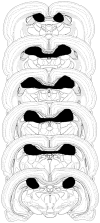Temporally graded retrograde amnesia of contextual fear after hippocampal damage in rats: within-subjects examination
- PMID: 9920672
- PMCID: PMC6782148
- DOI: 10.1523/JNEUROSCI.19-03-01106.1999
Temporally graded retrograde amnesia of contextual fear after hippocampal damage in rats: within-subjects examination
Abstract
We have shown previously that electrolytic lesions of the dorsal hippocampus (DH) produce a severe deficit in contextual fear if made 1 d, but not 28 d, after fear conditioning (). As such, the hippocampus seems to play a time-limited role in the consolidation of contextual fear conditioning. Here, we examine retrograde amnesia of contextual fear produced by DH lesions in a within-subjects design. Unlike our previous reports, rats had both a remote and recent memory at the time of the lesion. Rats were given 10 tone-shock pairings in one context (remote memory) and 10 tone-shock pairings in a distinct context (with a different tone) 50 d later (recent memory), followed by DH or sham lesions 1 d later. Relative to controls, DH-lesioned rats exhibited no deficit in remote contextual fear, but recent contextual fear memory was severely impaired. They also did not exhibit deficits in tone freezing. This highly specific deficit in recent contextual memory demonstrated in a within-subjects design favors mnemonic over performance accounts of hippocampal involvement in fear. These findings also provide further support for a time-limited role of the hippocampus in memory storage.
Figures






Similar articles
-
Hippocampus and contextual fear conditioning: recent controversies and advances.Hippocampus. 2001;11(1):8-17. doi: 10.1002/1098-1063(2001)11:1<8::AID-HIPO1015>3.0.CO;2-7. Hippocampus. 2001. PMID: 11261775 Review.
-
Hippocampus and medial prefrontal cortex contributions to trace and contextual fear memory expression over time.Learn Mem. 2013 May 17;20(6):336-43. doi: 10.1101/lm.031161.113. Learn Mem. 2013. PMID: 23685809
-
Absence of systems consolidation of fear memories after dorsal, ventral, or complete hippocampal damage.Hippocampus. 2008;18(7):710-8. doi: 10.1002/hipo.20431. Hippocampus. 2008. PMID: 18446823
-
Complete or partial hippocampal damage produces equivalent retrograde amnesia for remote contextual fear memories.Eur J Neurosci. 2007 Mar;25(5):1278-86. doi: 10.1111/j.1460-9568.2007.05374.x. Epub 2007 Mar 9. Eur J Neurosci. 2007. PMID: 17355254
-
Contextual fear, gestalt memories, and the hippocampus.Behav Brain Res. 2000 Jun 1;110(1-2):73-81. doi: 10.1016/s0166-4328(99)00186-2. Behav Brain Res. 2000. PMID: 10802305 Review.
Cited by
-
Thy1-hAPP(Lond/Swe+) mouse model of Alzheimer's disease displays broad behavioral deficits in sensorimotor, cognitive and social function.Brain Behav. 2012 Mar;2(2):142-54. doi: 10.1002/brb3.41. Brain Behav. 2012. PMID: 22574282 Free PMC article.
-
Basolateral amygdala and ventral hippocampus in stress-induced amplification of nicotine self-administration during reacquisition in rat.Psychopharmacology (Berl). 2015 Aug;232(15):2741-9. doi: 10.1007/s00213-015-3911-4. Epub 2015 Mar 15. Psychopharmacology (Berl). 2015. PMID: 25772339
-
The role of the dorsal hippocampus in the acquisition and retrieval of context memory representations.J Neurosci. 2004 Mar 10;24(10):2431-9. doi: 10.1523/JNEUROSCI.1598-03.2004. J Neurosci. 2004. PMID: 15014118 Free PMC article.
-
Involvement of the GABAergic system in PTSD and its therapeutic significance.Front Mol Neurosci. 2023 Feb 1;16:1052288. doi: 10.3389/fnmol.2023.1052288. eCollection 2023. Front Mol Neurosci. 2023. PMID: 36818657 Free PMC article. Review.
-
Cholinergic modulation of Pavlovian fear conditioning in rats: differential effects of intrahippocampal infusion of mecamylamine and methyllycaconitine.Neurobiol Learn Mem. 2007 Mar;87(3):441-9. doi: 10.1016/j.nlm.2006.11.001. Epub 2006 Dec 18. Neurobiol Learn Mem. 2007. PMID: 17178240 Free PMC article.
References
-
- Blanchard DC, Blanchard RJ, Lee MC, Fukunaga KK. Movement arrest and the hippocampus. Physiol Psychol. 1977;5:331–335.
-
- Bolhuis JJ, Stewart CA, Forrest EM. Retrograde amnesia and memory reactivation in rats with ibotenate lesions to the hippocampus or subiculum. Q J Exp Psychol B Comp Physiol Psychol. 1994;47:129–150. - PubMed
-
- Bolles RC. Species–specific defense reactions and avoidance learning. Psychol Rev. 1970;77:32–48.
-
- Cho YH, Kesner RP. Involvement of entorhinal cortex or parietal cortex in long-term spatial discrimination memory in rats: retrograde amnesia. Behav Neurosci. 1996;110:436–442. - PubMed
Publication types
MeSH terms
Grants and funding
LinkOut - more resources
Full Text Sources
Other Literature Sources
Research Materials
